Content Marketing Strategist
Adapting your keyword research to UX for a website redesign
Content Marketing Strategist
We mostly know keyword research as an SEO tool for creating content. We develop content strategies around user needs and search intentions, and we draft content related to the brand. The result? The brand becomes highly relevant in the eyes of users, because its message corresponds to what those users are searching for.
But what if I told you that keyword research could be useful for something other than creating content? Like, for a website redesign, for example? Crazy, right?

While collaborating on redesign projects with colleagues in customer experience, I realized that the keywords that position (or don’t) a brand can provide an interesting perspective for creating information architecture. If you combine keyword research with quantitative data sources like Google Analytics, and qualitative ones like user testing, the perspectives that emerge can deliver a lot of value to a team in charge of redesigning or optimizing a site. All this in the aim of offering the best possible customer experience on a website.
In this article, I’ll be identifying the synergies between these two complementary areas of expertise (SEO and user experience), and I’ll explain how keyword research can help determine the structure of a new website.
What is the role of each field of expertise in the user journey?
Let’s start by defining the steps that make up a typical user search. To illustrate, I’ll use the example of a search I carried out recently while planning a trip to New York.

Step 1: The search
With the goal of finding the best food in New York, I go to the Google homepage. My search intention will either be informational, transactional or navigational.
Informational
The user’s intent is to seek out information on a particular question or subject. They aren’t considering brands for the time being, they are simply looking for the best answer to their question.
- In my case, I would simply be looking to inform myself about New York’s food specialities. I would enter search queries like, “what to eat in New York” or “New York’s best food.”
Transactional
The user has a more specific intention. They are more informed or educated, and want to accomplish a key task on a website. Note that the expression “transactional” doesn’t necessarily refer to a purchase. There are a myriad of transactions you can carry out on a website: subscribing to a newsletter, reading an article, downloading a guide, etc.
- I am clearly going to eat pizza, and it needs to be close by. So, my next move is to search for “Pizza in Brooklyn.”
Navigational
The user’s intention is directly brand-related. They are looking to accomplish a specific task.
- A friend told me that “Pizzeria XYZ” makes the best pizza in New York. I therefore search for “Pizzeria XYZ New York” to find out where they are and see a menu.
Step 2: Results
The search engine returns search results categorized in order of how relevant they are to the user’s question. The user identifies the link that seems to best respond to their needs, and moves onto the next step.

Step 3: Arrival on your website
Persuaded by the title and description of your page link, the user chooses to click the link and arrives on your website.
In that moment, two things can happen:
- Your page content corresponds to what the user is looking for and they continue navigating on your site.
- Your page content doesn’t correspond to the user’s needs. They decide to go back to the previous step and continue searching.
The thing to retain is that every user query represents a potential portal of entry to your website. That’s why SEO and user experience need to be aligned. The goal? To improve the overall user experience, from the initial search right up to when the user accomplishes their goal.

The role of SEO in the user journey
SEO works on multiple fronts to improve the way pages are ranked in search.
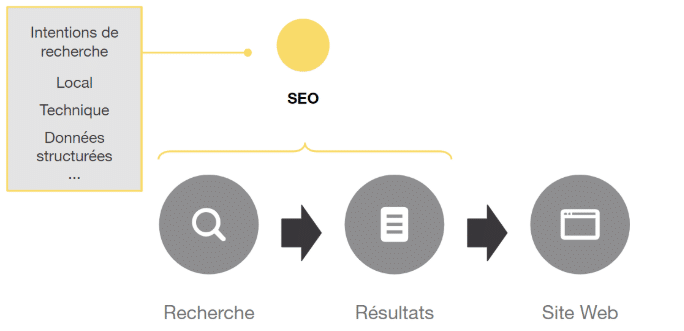
Google’s algorithm includes more than 200 criteria that influence the position a page will occupy in search results. As a result, you need to ensure that:
- Page content responds to a search intention. It should be high quality and exhaustive.
- Search engines are able to understand the elements of local SEO, where localization files are relevant, e.g. finding a store.
- Technical elements are respected. For example, URL nomenclature, H1, H2, H3 tags, Alt image tags, etc.
- Site pages contain structured data, so your pages can be correctly indexed and users can be given rich results.
The arrival of UX into the journey
UX comes into play the second a user arrives on your site. User experience plays a role in all the elements that make the user journey a success:
- Respond to users’ motivations. What was their primary intention before arriving on the webpage?
- Allow users to easily carry out key tasks, for example, making an appointment, subscribing to content, purchasing a product, etc.
- Ensure that the site respects best practices in usability and accessibility.
- Understand users’ frustrations and optimize the site to minimize friction.
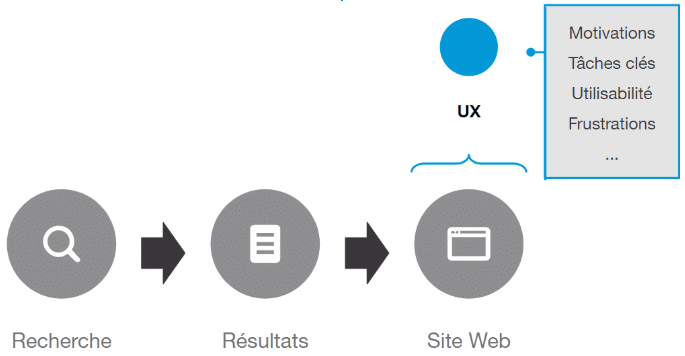
The common ground between SEO and UX
SEO and UX need to work together closely during a website redesign or optimization program. Why? Because SEO allows you to identify, first of all, points of entry from which a user might arrive on the site. It also allows you to determine whether or not the site’s current content is discoverable through search.
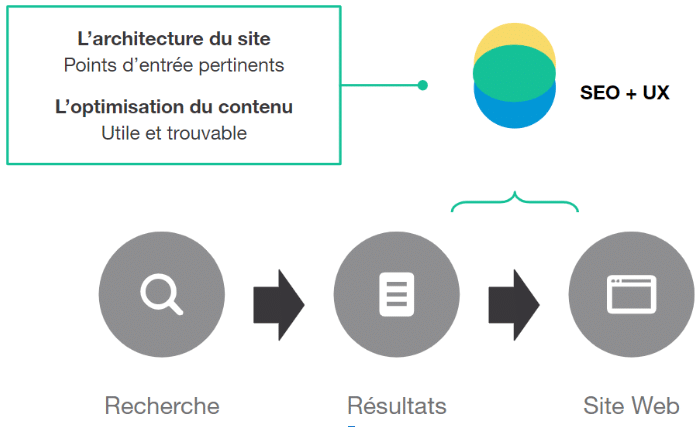
Researching keywords for UX
In the first part of this article, we put ourselves in the position of the user. Now, we’re going to put ourselves in the shoes of Pizzeria XYZ, who want to redo their website, and are trying to gather insights to help with their future site structure.
When you analyze keywords for a site structure, you want to determine two things:
- What keywords is my site currently positioned for? (internal research)
- What keywords should my site be positioned for in the future? (external research)
I mostly use tools like Google Search Console and Ahrefs.com, but you can get the same results with other tools like Keywordtool.io or Ubersuggest. If you don’t have Google Search Console, the analysis tool from Ahrefs.com will do the job, although it’s considerably less precise and has a larger margin of error.
1. Internal research: the keywords my site is positioned for
I want to understand what the current points of entry are to my website. How are users actually getting there? Is it because they are already very familiar with the brand? Is it because they’re looking for a specific product? To find out, I need to export my data from Google Search Console.
By exporting the data showing which keywords have been driving traffic to the Pizzeria XYZ website over the past year, I can now see what’s working well on my current site.
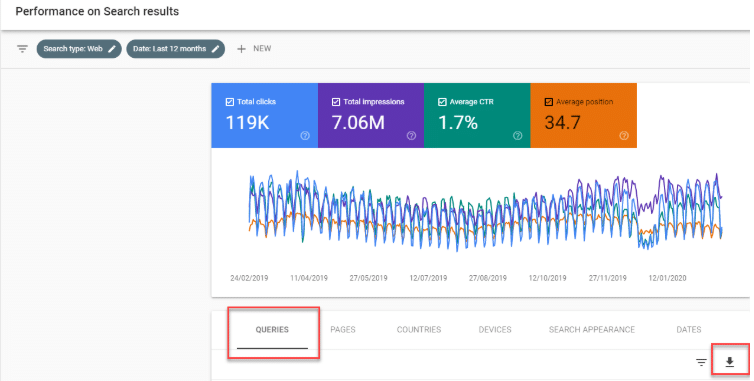
Once I’ve extracted the list, I can start categorizing keywords. My categories might be based on the sections of my site (e.g., careers, menu, about, etc.), or on product categories (e.g., pizza, pasta, cocktails). In short, analyzing keyword redundancies can help us detect categories that might be useful as we start to define our new architecture. Here’s an example of what an analysis of data extracted from Google Search Console might look like:
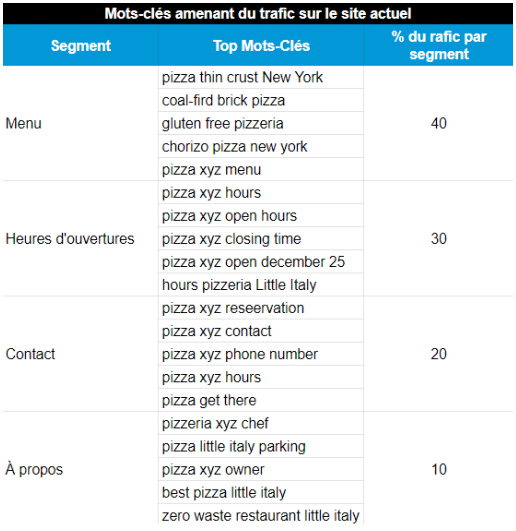
This visualization helps us see, for example, where our brand is positioned, and how our content is performing as things stand.
2. External research: keywords we want to be positioned for in the future
Now that we have a good idea how keywords are performing on our current site, the next interesting step is to try to find unexplored opportunities that the new site might be able to exploit. To do this, we’ll need to do keyword research to identify queries that might have potential for the brand. To do that, we’ll need to think like a user. We can start by looking at branded phrases. Personally, I love questions! A question is pure gold in SEO… I might also look at non-branded queries related to my product and service offering.
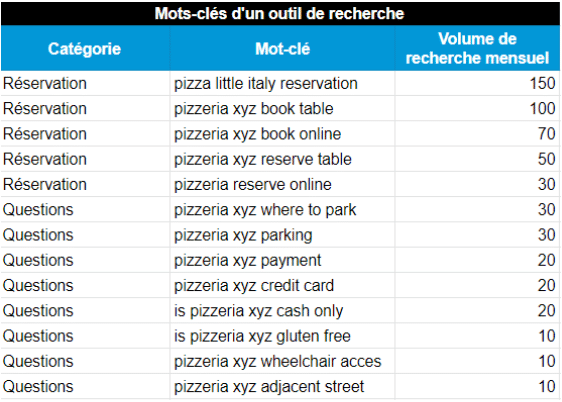
Once we’ve gathered our keywords together, we can group them into categories and draw out insights that will guide our redesign or optimization plan for the site.
The idea is to note it all down, and compare the results with the analysis of our actual keywords.
From research to site structure
Now that we’ve got our data in good shape, we can start to compile our findings. Here are a few examples (fully fabricated, of course):
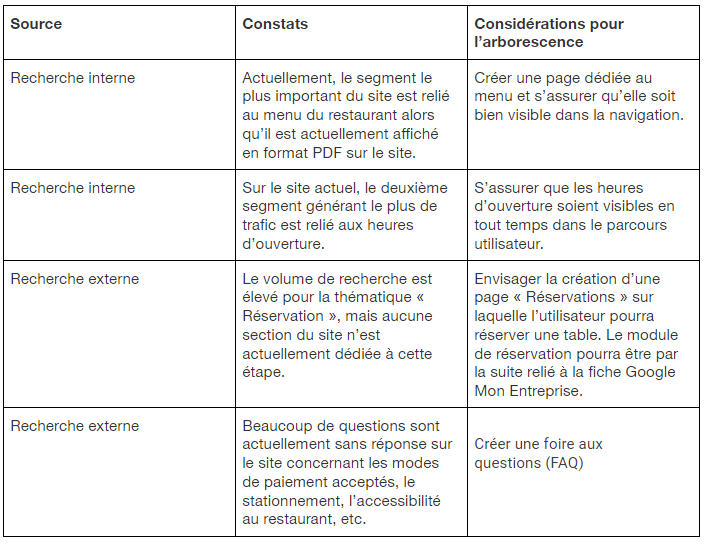
The pizzeria example is a simple one, but the principles we’ve looked at hold true regardless of the complexity of your site. SEO occupies a very important place in a website redesign project, because it’s responsible for how discoverable your site is in search.
A website redesign can be complex and involve a multitude of stakeholders. If you don’t know where to start, our experts can provide the guidance and support you need to reach your business goals!












